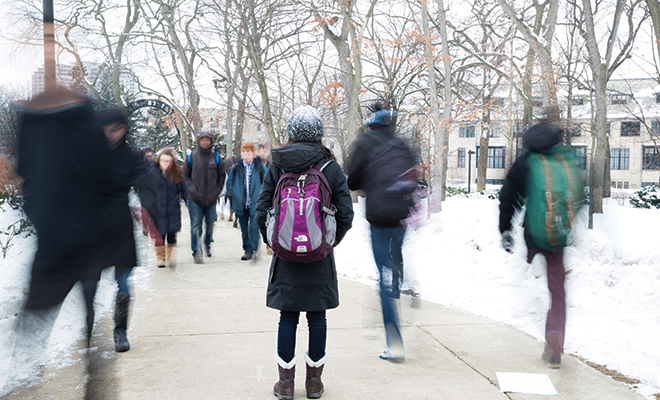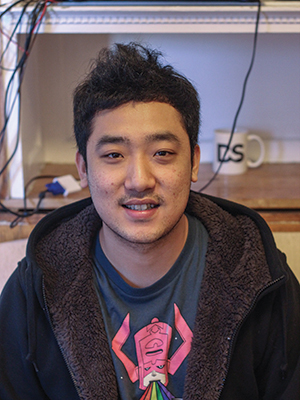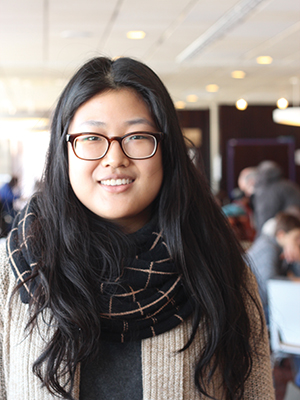
On May 12, 2013, in the cool darkness of a sound-recording room, I decide I hate my voice.
I’m reading a narration into my voice recorder, the last bit of audio to record before I edit it into a clip for journalism class. Playing back the recordings, I hear my voice exposed in its full, naked glory. My tongue forgets to roll its ‘r’s, my ‘th’s’ are deflated and my flat and unsophisticated Singaporean accent grates on my nerves. I sound like a parody of the professional newscasters we’ve been taught to emulate.
My voice is a puzzle piece that doesn’t fit.
As I give up and rewrite the whole script to exclude my narration, the realization hits me.
I am a puzzle piece that doesn’t fit.
—

Back home in Singapore, my high school teacher once praised me for my public speaking skills, and as a theater kid, I’d always loved the reverberations my voice would make in an empty auditorium during rehearsal, the rhythms and rhymes when I read a poem aloud in class. Here in the U.S., my voice instantly flags me as different to an audience with whom I’m supposed to communicate effectively as a journalist. It happens when I speak up to reach out to a stranger, to make a new friend, to just say “hi.”
It makes me wish I were different from who I really am, a foreign-born, third generation Singaporean Chinese who grew up in a humid Southeast Asian urban jungle, a foreign-born who spent many an afternoon as a child poring over the great American and British classics, who fluidly switched between speaking and writing English and Mandarin Chinese in school, who ate fish and chips and burgers but also loved dumplings and fried rice. Still, even with my student visa tucked in my drawer, there’s always something lost in translation between Singapore and Evanston, always something reminding me I’m an outsider.
Usually, those reminders are subtle. Sometimes I’ll be listening in on conversations filled with terms of endearment, celebrity gossip or even units of measurement—terms I have to surreptitiously Google. Or it’s those moments when, upon hearing my accent, people instantly ask me where I’m from.
But sometimes, they come as a slap in the face. Once, someone told me he’d figured out what he called a “social hierarchy” of Asians based on how well they dressed. He said he could tell Asians apart because Asian-Americans were the most fashionable, while international students from China—and Singaporeans, he added, when I challenged him to place me in his system—were at the bottom of the pile for their frumpy clothes and awkwardness.
Another time, I overheard a group of people making fun of a Beijing-born international student for her accent, enthusiasm in class and cheap clothes. I wondered what they thought of me.
People tell me to “just be myself” and not worry about what others think.
I know my most notable character traits are my strong work ethic, my fiery ambition, my fierce passion for what I put my mind to. Now at Northwestern, I wonder how people perceive me. I wonder why, on occasion, they wrinkle their noses in disapproval when they see me wildly annotate a poem with my thoughts and ideas. I wonder if they know I apply for committees and leadership positions just because I like being involved and busy.
To them, am I just one example of the hardworking Asian stereotype? Am I allowed to be the usual geeky literature fan I always was without people attributing it to my “Asian-ness?”
It’s so much harder to figure out what makes me unique, what personality traits I can be proud of, when there are parts of me that people have demarcated as typical of some stereotype.
I don’t want to be ashamed of myself. But what can I be proud of?
—
In the spring of 2012, a group of Northwestern student leaders started the Asian NU Project (ANUP) to answer that question about identity for themselves.
It is May 24, 2012 and the atmosphere at the Northwestern campus is charged. About 200 students are marching up and down Sheridan Road, chanting for Asian pride and solidarity. High above their heads are signs emblazoned with phrases like, “I support the Asian community” and “Proud to be Asian.”
This march is a culmination of ANUP’s bi-weekly discussions and workshops in May, a nod to Asian-American and Pacific Islander Month. ANUP aimed to bolster unity and pride among Asian-American students about their identities. Although they targeted mostly Asian-Americans in their advertising, international students and students of other minority ethnicities also attended to share stories about their experiences as minorities.
Two weeks before the rally, ANUP also hosted a dinner attended by 150 students and administration members including President Morton Schapiro. The discussion of the night revolved around the question, “Why do all the Asians sit together?”
—
On the night of April 21, 2012, the Northwestern Ski Team hosted a party now seared into the collective Northwestern memory as the “Racist Olympics.” About 50 students dressed in offensive mock-ups of several cultures: headdresses and war calls for Native Americans, white tops and black pants to symbolize the “South Africans” and the country’s apartheid regime.
Photos and social media posts spread like wildfire and the incident became a hot-button issue on campus. An open ASG-held forum on the issue attracted nearly 200 students.
To add fuel to the fire, on the evening of May 8, 2012, two then-seniors in Weinberg Sasijaree Rianterawongs and Priyanka Seshadri were at the outdoor tennis courts by Colfax Street when a man threw eggs and an open water bottle at them and shouted, “Fuck you, Asians.”
ANUP was not started as a reaction to these events, but they were alive in the minds of its participants.
—

Looking back, Weinberg junior MJ Kim says that as a freshman, being an ANUP rally organizer was his greatest learning moment in college.
“ANUP provided a safe space where we could all discuss our identities,” he says. “We could talk about our lives, share our stories and become friends.”
Kim grew up in South Korea before moving to Marshfield, Wis., for high school. Living in a majority-white town meant that Kim had to quickly assimilate into American culture.
Although he felt close to his classmates by graduation, he also realized along the way that displaying his ethnicity on his sleeve could attract attention for the wrong reasons.
For his first high school homecoming, he dressed in hanbok—a vibrantly colored Korean dress worn during traditional festivals and celebrations—and found himself sticking out amid a sea of dresses and blazers.
“I thought it’d be great to share my culture with everyone,” Kim says. “I got teased a bit for it, and felt pretty ashamed about it.”
Through sharing his experiences and listening to others at ANUP events, Kim says he learned to be proud of who he was, but he also realized the problems within the Asian and Asian-American communities and stereotypes about Asians continue to persist at Northwestern. He also learned the Asian-American community was segmented along fault lines, with people of some ethnicities preferring to hang out with those of the same background.
“There were deep, clear borders visible to all,” he notes. “There was a need to unite the Asian community with the Northwestern community, and unite the separate groups within the community as well.”
—

For Weinberg junior Rex Tai, participation in ANUP his freshman year showed him the immense diversity of experiences within the Asian-American community.
Attending high school in Kansas, he found himself in good company as one of 150 Asian students among a student population of 1,600. He considered himself proud of his identity—he listened to K-Pop, watched anime and ate East Asian food.
At Northwestern, he realized that not everyone grew up with a similar sense of pride toward their identities, but he soon learned the merit of simply listening to the personal accounts of their struggles.
“Even if you don’t feel the shame that other people do, by being part of the community, you can support those who do struggle with issues of shame, and share with them your sense of pride,” he says.
Given the ongoing tension surrounding the ethnicity-related incidents on campus in 2012, Tai says reactions from the student body toward ANUP were mixed. There were some who stood in solidarity. There were many who were apathetic.
And then there were also those who opposed ANUP, Tai says, because they thought having students talk so openly about their ethnicity would only make their minority status more prominent, adding fire to the existing tension.
“But we felt we just couldn’t not talk about it,” Tai says.
ANUP petered out before Fall Quarter 2012, right as I entered Northwestern as a freshman. Many in the core organizing group had graduated and felt the group had accomplished what it had set out to do that year. Without a tangible project or direction, it was hard to reorganize in the new academic year, Kim explains.
—
Out of 451 international student undergraduates enrolled in Northwestern during my freshman year, 302 hailed from South Korea, China and Singapore. One in five students in my class identify as Asian-American. Both ASG presidents during my Northwestern career—the incumbent, Ani Ajith, and predecessor, Victor Shao identify as Asian-American.
Yet, I still felt like a fish out of water. In the absence of a safe space where I could share my experiences, I struggled.
It was hard to know who to turn to when I was told I spoke English well for an international student, when people told me to my face that they didn’t expect me to know the meaning of certain words just because I was Asian.
I didn’t know if the feelings of alienation, shame and confusion toward my identity were normal.
I always felt like I was sitting on the margins watching an elaborate football game where I was expected to know the rules. I was always figuring out my next game plan to blend in.
—
So in this murky game, I started playing dirty.
I realized it was much easier to pretend not to be different than to admit who I really was. I internalized my sense of alienation and shame, but with a cruel twist.
I remember walking 10, then 20 steps ahead of my parents when they came to the United States with me during Wildcat Welcome, wishing they wouldn’t talk so loudly in their broken English about craving fried rice.
When they visited me again in the middle of Fall Quarter, they brought me a treat from home. My mother had cooked my favorite dish: Indonesian fried chicken with her special chili sauce and coconut rice. They had figured a way to store it carefully in a vacuum-sealed bag and flown it halfway across the world for me. Yet, all I remember was wishing they’d kept it—kept themselves—out of sight.
I remember standing at the Norris Wildcat Wok station in line with other Asians I didn’t know. They were speaking in a chatter of their home languages. I stepped aside, slightly out of the line, just to make it clear to an invisible audience that I was different.
Every time incidents like these happened, I felt guilty and confused about my own actions.
But still, I hesitated to raise my hand to read a poem in class. I avoided mentioning my hometown during start-of-quarter class introductions. I joked about people who are “fresh off the boat” (FOB).
I stopped being honest with myself about who I really was.
—

I didn’t realize there were different ways of dealing with the pain of being an outsider, that I could speak out and defy social expectations dictating who I was supposed to be.
SESP senior Michelle Ki did. Her family moved from South Korea to Memphis, Tenn., when she was eight years old in 1999, and then to a primarily white suburb in St. Louis, Mo, in 2001. In the U.S., she found that many people expect her to translate for her parents even though they speak conversational English.
“When I was with my parents, people would look to me to speak for the family,” she says. “I’d force people to talk to my parents and stop ignoring the fact that they’re clearly there.”
Then in her Introduction to Social Inequality class Fall Quarter of her freshman year, Ki discovered how she could put her experiences in a broader perspective. She learned about immigration and realized that her parents, South Korean computer science majors, were just among many immigrants who have historically faced systemic barriers as they tried to convert the professional accreditations they obtained at home for employment in the United States.
As a high schooler, Ki struggled with a sense of shame toward her parents, heightened by feelings of socioeconomic and ethnic disparity. “I used to be embarrassed that parents owned a beauty supply store while my friends’ parents worked as doctors and lawyers,” she says. But in that sociology class, Ki found a way to place herself and her experiences within a greater historical narrative.
“For the first time, I found the vocabulary to express the thoughts I had always had as a 1.5 generation Korean living in a white suburban environment,” she says. “The thoughts and struggles I had were suddenly validated.”
I used to think it was easier to keep silent about the hurt and confusion.
It’s harder to speak out and share your experiences, to ignore that racehorse heartbeat, that dry throat, to tell someone else, “I felt that way too.”
I can’t pinpoint what made me realize I had to see things differently. Perhaps it was the sad confession from my high school best friend this summer, that in college on the East Coast she, too, wished people didn’t label her as a FOB. Perhaps it was the inexplicable excitement rushing through my veins when I met a Thai-American Northwestern alumnus who described how his Asian Pacific American Coalition (APAC) presidency and on-campus activism transformed his Northwestern experience and how he viewed his race and ethnicity.
And then I realized. By speaking out about our differences, we make it easier for ourselves and easier for those around us to come closer to understanding who we truly are. We learn from one another about what living in a multiethnic, multicultural society means and how we can treat each other with more respect in our daily lives.
We learn we’re not alone, and that there are threads of similarities linking our experiences. We discover ourselves within other people. We turn our differences into pillars of strength.
There is a tiny spark within each of us that could turn into a fire of passion, of introspection about ourselves and who we are, if we let those flames grow. Those firestarters can be engaging in discussions with each other about your identity, taking a class about your ethnicity or someone else’s. It can be unlearning the behaviors of silently othering people who are different from you. For one and a half years in my Northwestern career, I’ve kept silent about this struggle when it needs to be spoken aloud. Four months ago, I decided I had to start something.
I reached out to MJ, Michelle, Rex and countless others. I researched on the Internet. I filled notebooks and Word documents of interview transcripts, doodles, notes detailing my reflections on my identity.
And then, I wrote this story.